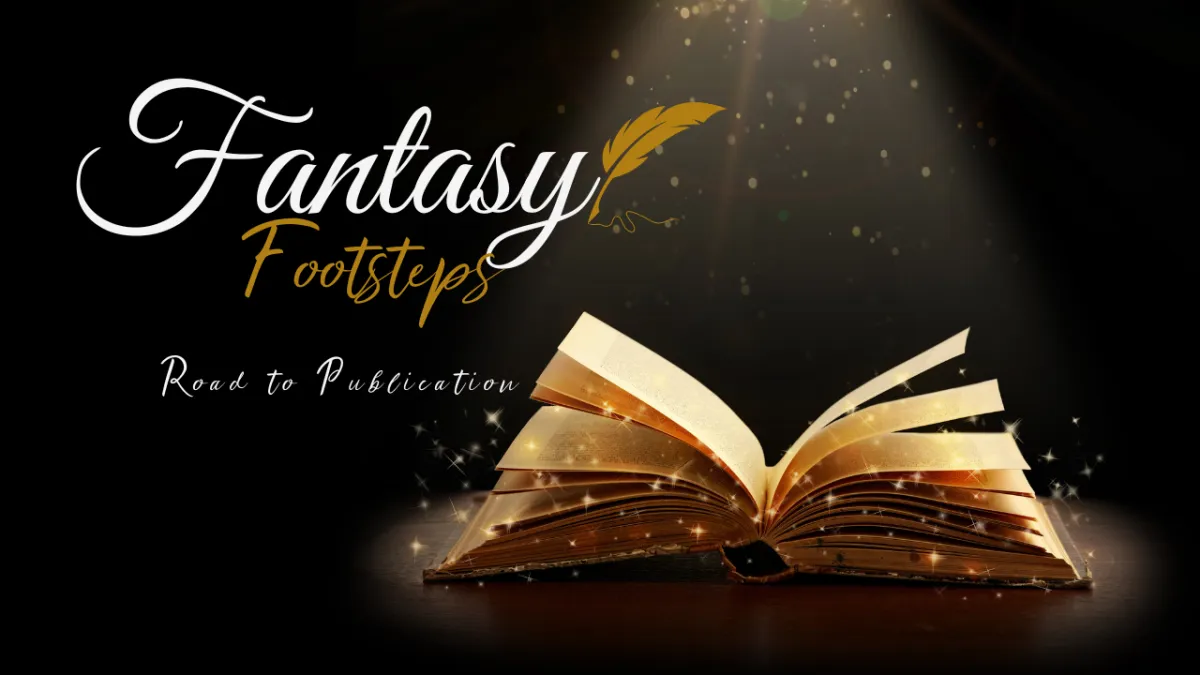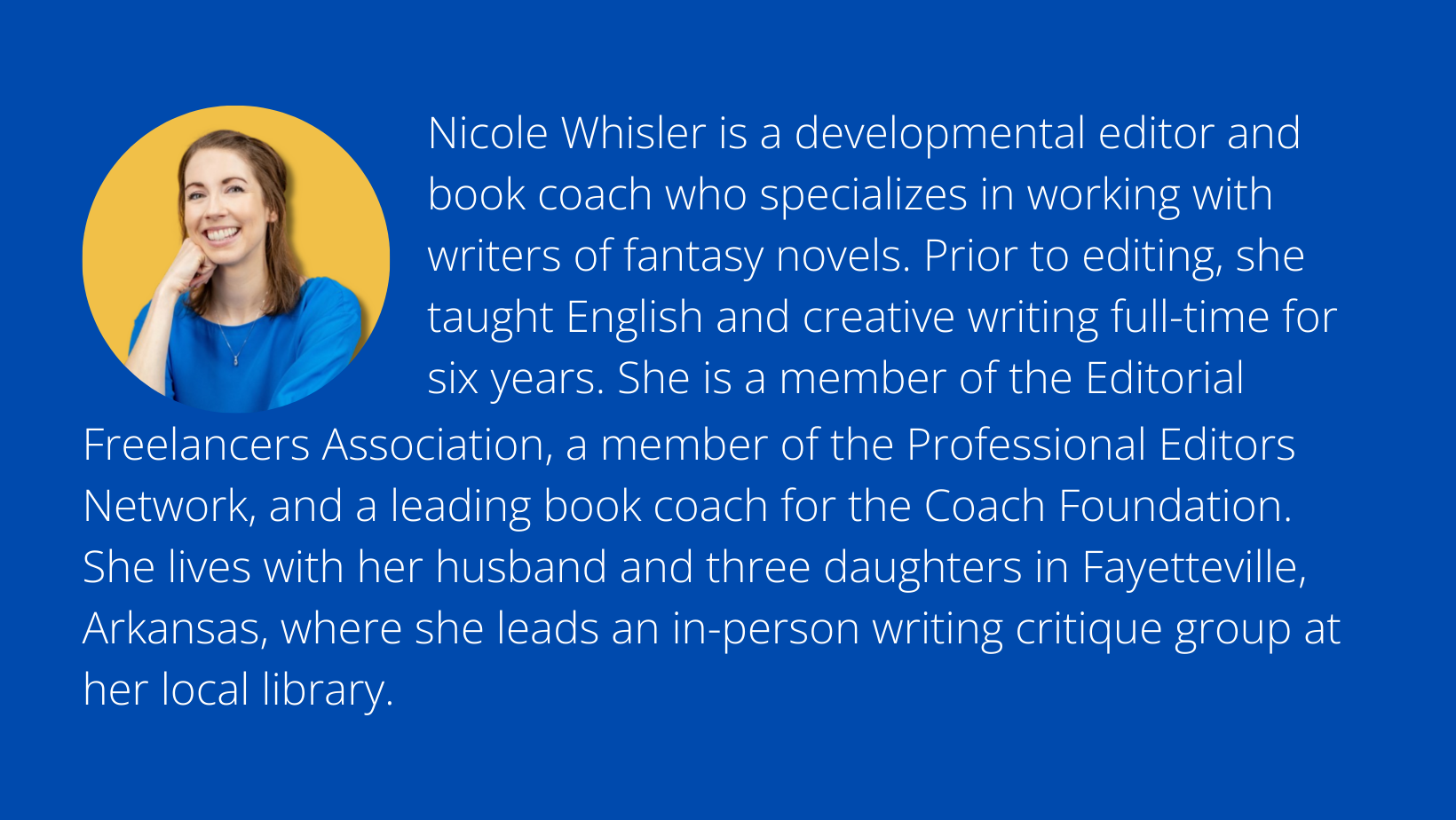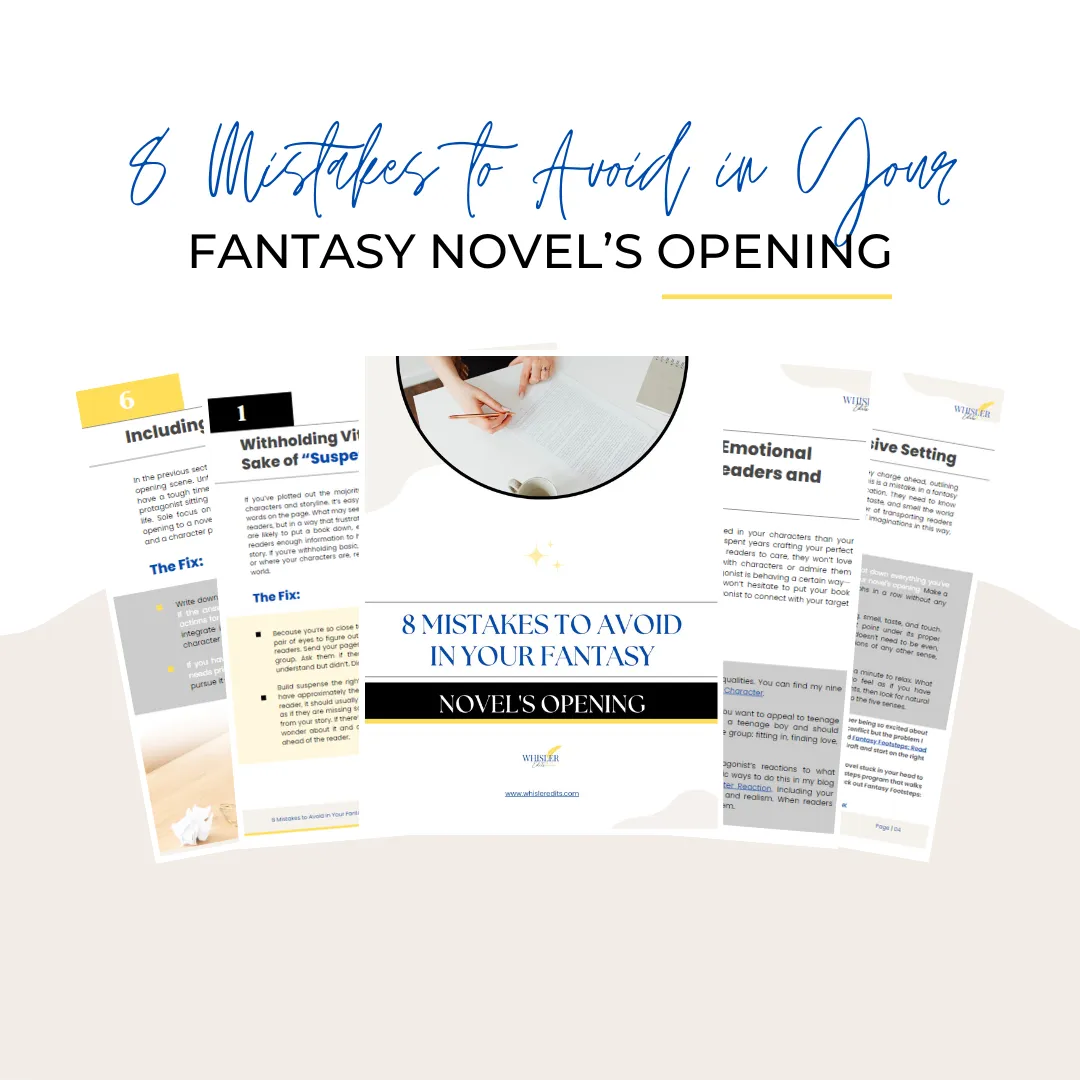8 Mistakes to Avoid
in Your Fantasy Novel’s Opening
Don’t let common mistakes lose your readers!

Your Novel Matters ...
Looking for the right book coach for your fantasy novel?
Are you a fantasy writer …
… struggling to convert the vivid scenes of your fantasy novel from your imagination to the page?
… stuck in a loop where you constantly rewrite your opening pages?
… worried your story won’t resonate with your readers?
What if I could show you the exact steps week to week that would take you from brainstorming and drafting to revising and publication?
I specialize in developmental editing and book coaching for writers of fantasy novels—writers who value the craft of storytelling and wish to create stories that resonate.
My Services
Develop Your Ideas
Fantasy Footsteps: Road to Publication

I’ll let you in on a secret. All you need to succeed as a writer are three things:
A Roadmap: Illuminate your path with a step-by-step guide, ensuring you achieve your writing goals every week. From outlining to publishing, every stage of your journey is mapped out for success.
Mindset Mastery: Learn how your thoughts control your outcomes in your writing. Overcome self-doubt and unearth the confidence that will bring your unique ideas to life on the page.
Personalized Support: Prepare for comprehensive assistance, real-time accountability, and feedback tailored to your needs. From brainstorming sessions to final publication, you'll have a dedicated ally guiding you every step of the way.
With these three pillars, you'll unlock the potential to:
Craft a captivating story that enthralls readers from the first page to the last.
Develop complex characters and immersive worlds that resonate deeply with your audience.
Navigate the complexities of plot twists and pacing, keeping readers hooked until the final chapter.
Receive specific guidance on refining your scenes so that readers root for your protagonist.
Overcome writer's block and stay motivated throughout your writing journey, ensuring consistent progress.
Transform your rough draft into a polished, professional manuscript ready for publication.
Are you ready to turn your fantasy novel from a mere vision into a masterpiece that captures hearts and minds?
Join Fantasy Footsteps: Road to Publication and begin your author journey with everything you need to write a story that works.
Don't let your story remain trapped in your mind—bring it to life with me!
If you’re thinking, “Yes, please! Tell me what to do!” , I’d like to invite you to work one-to-one with me to finish your novel and write a story that works. Join my book coaching program designed specifically for fantasy writers—Fantasy Footsteps: Road to Publication.

Discover Helpful Tools
Resources For Writers
Here you will find some of my favorite resources for writers.
Add these books, podcasts, websites, and other resources to your writing toolbox to augment your writing at any stage.
Join My Free, Private Facebook Group
Finish My Fantasy Novel: Write & Revise My Best Book in 6 Months
In the group, I go live weekly with writing tips. The group is also a platform for writers to support each other and share their wins and progress.
Live training schedule:
1st Tuesday of the month: Free critique for someone in the group!
2nd Tuesday of the month: Writing sprint with fellow writers
3rd Tuesday of the month: Live training on a specific topic
4th Tuesday of the month: Interview with an author or marketing/business expert


Improve Your Craft
Writing Advice Blog
As a developmental editor and book coach, everything I post is designed to help you build your creativity, strengthen your prose, and explore new avenues in your writing. The opinions in each post are my own, but many are inspired by ideas from established authors and editors who excel in their fields.
Rely on my blog for clear and specific writing advice, motivational tips and grammatical aid, and interviews with experts!
Hi! I'm Nicole.
I’m a Developmental
Editor & Book Coach for Fantasy Writers.
Like you, I'm a writer. I understand the mental and emotional ups and downs of storytelling. Don't let resistance win! Recognize the value of good advice plus hard work.
My approach to novel writing is multifaceted. For a deeper understanding of my process and style, take a look at some of my favorite craft-of-writing books in my Resources section.
What can I say about myself? I read, I write, I read about writing, and I write about reading. It never gets old to me.

See what writers like you are saying . . .

Nadir Shirazi
“I’ve been stalling on my Islam-inspired sci-fantasy series for 10 years. But within 10 minutes of starting Nicole’s program, I started writing again."

Amanda Emerick
“I can’t recommend Fantasy Footsteps enough to writers who are legitimately looking to polish their craft, write, and eventually publish their novel."

Trinity Cunningham
“I loved discussing my story with Nicole. She provided me with invaluable insights I never would have considered on my own."
Latest on the Blog

You will find no pictures of kittens here. No images of favorite dessert recipes, snapshots of my recent vacations, videos of puppies playing the piano (although I do love dogs), or YouTube clips of monkeys stealing people’s sunglasses.
I’m genuinely sorry if that disappoints you.
Instead, you can rely on my blog for clear and specific writing advice, motivational tips, grammatical aid, and author/editor interviews.
As a developmental editor & book coach, everything I post is designed to help you build your creativity, strengthen your prose, and explore new avenues in your writing. The opinions in each post are my own, but many are inspired by ideas from established authors and editors who excel in their fields.
Some of these tips might be just what you need to hear. Others might not work for you personally, and that’s okay.
Apply the tips that fit your personality and writing habits, and feel free to adapt or ignore the others. For further questions and comments, you can email me or reach me through my Contact page.

Show & Tell: What’s Best for My Story?
Discover in this post …
whether “Show, don’t tell” is a myth
examples of showing and telling at the scene level and the sentence level
when to show and when to tell to create a cohesive story
Is “Show, Don’t Tell” a Myth?
You’ve likely heard the writing advice “Show, don’t tell.” Someone may have looked down their nose at you and said something like …
“Telling is terrible writing.”
“You should always show.”
“Don’t you want to immerse your reader?”
Here’s my take: I didn’t title this blog post “Show, Don’t Tell” or even “Show vs. Tell.”
The AND is intentional. Showing and telling are not at odds with one another; rather, they work together to create a cohesive story. They’re friends, not enemies. And they’re looking to you, the writer, to decide which fits best in each context.
So how do you decide? In a bit, we’ll discuss guidelines regarding when to use each in your novel. But first, let’s assign a clear meaning to the terms.
Distinguishing between Showing & Telling
Showing and telling apply in two main ways in a novel:
At the scene level
At the sentence level
At the scene level, showing occurs when you, the writer, immerse readers in a specific scene. You’re helping readers feel as if they’re “in the moment” with your characters. Often, you’ll appeal to the five senses (sight, hearing, taste, touch, and smell).
Telling at the Scene Level
Telling, at the scene level, means you’re summarizing information that’s not happening in real time. Perhaps you’re explaining something that has already occurred, taking readers through a few quick events to bring them up to speed, or providing exposition.
The distinction between showing and telling at the scene level is best illustrated by example. Here’s an excerpt from Harry Potter and the Sorcerer’s Stone that tells (shortly after Harry has arrived at wizarding school):

“There were a hundred and forty-two staircases at Hogwarts: wide, sweeping ones; narrow, rickety ones; some that led somewhere different on a Friday; some with a vanishing step halfway up that you had to remember to jump. Then there were doors that wouldn’t open unless you asked politely, or tickled them in exactly the right place, and doors that weren’t really doors at all, but solid walls just pretending. It was also very hard to remember where anything was, because it all seemed to move around a lot. The people in the portraits kept going to visit each other, and Harry was sure the coats of armor could walk.
“The ghosts didn’t help, either. It was always a nasty shock when one of them glided suddenly through a door you were trying to open. Nearly Headless Nick was always happy to point new Gryffindors in the right direction, but Peeves the Poltergeist was worth two locked doors and a trick staircase if you met him when you were late for class. He would drop wastepaper baskets on your head, pull rugs from under your feet, pelt you with bits of chalk, or sneak up behind you, invisible, grab your nose, and screech, ‘GOT YOUR CONK!’
“Even worse than Peeves, if that was possible, was the caretaker, Argus Filch. Harry and Ron managed to get on the wrong side of him on their very first morning. Filch found them trying to force their way through a door that unluckily turned out to be the entrance to the out-of-bounds corridor on the third floor. He wouldn’t believe they were lost, was sure they were trying to break into it on purpose, and was threatening to lock them in the dungeons when they were rescued by Professor Quirrell, who was passing.”
The above excerpt represents only a small section of four pages of telling—an intentional decision J. K. Rowling made to introduce readers to Harry’s new life at Hogwarts. This choice, naturally, was not her only option. She could have shown the quirks of each staircase with a separate, immersive incident. She could have placed readers directly in the moment with Harry as he encountered each ghost. She could have created a full scene in which Harry and Ron get in trouble with Filch.
But she didn’t.
Instead, she wisely chose to summarize the information. She tells, and it works wonderfully. We can learn three other valuable lessons from her decision in the excerpt:
Use unique details to make events memorable, like Peeves pelting the students with bits of chalk. If you’re boring yourself with your telling, you can bet readers will be bored too!
When appropriate, use occasional speech to add interest (such as “GOT YOUR CONK!”).
Include details essential to the overarching plot. The forbidden third-floor corridor, mentioned so casually in the excerpt, becomes vital to the climax of the story. Details are not random but part of an intricate storyline.
Showing at the Scene Level
Now let’s look at an example of showing at the scene level. In the following excerpt, also from Harry Potter and the Sorcerer’s Stone, Harry is in Diagon Alley with Hagrid and is about to receive his wand:
“The last shop was narrow and shabby. Peeling gold letters over the door read Ollivanders: Makers of Fine Wands since 382 B.C. A single wand lay on a faded purple cushion in the dusty window.
“A tinkling bell rang somewhere in the depths of the shop as they stepped inside. It was a tiny place, empty except for a single, spindly chair that Hagrid sat on to wait. Harry felt strangely as though he had entered a very strict library; he swallowed a lot of new questions that had just occurred to him and looked instead at the thousands of narrow boxes piled neatly right up to the ceiling. For some reason, the back of his neck prickled. The very dust and silence in here seemed to tingle with some secret magic.
“‘Good afternoon,’ said a soft voice. Harry jumped. Hagrid must have jumped, too, because there was a loud crunching noise and he got quickly off the spindly chair.”
Notice how Rowling appeals to multiple senses. Harry hears the “tinkling bell” when he enters the shop and the “loud crunching noise” as Hagrid stands. He sees the “[p]eeling gold letters” above the door and “thousands of narrow boxes piled neatly right up to the ceiling.” He feels “the back of his neck [prickling].” Rowling even addresses taste on a figurative level, stating that Harry “swallowed a lot of new questions that had just occurred to him.”
In this way, we’re immersed in the scene alongside Harry, uncovering the events sentence by sentence. When done well, showing excites and intrigues readers, leading them by the hand deeper into the story.

Showing & Telling at the Sentence Level
Now we’ve arrived at the second, smaller way we can apply showing and telling in a novel: at the sentence level. Let’s dive into three main areas:
Adverbs in prose
Dialogue tags
Emotion words
1. Adverbs in prose
Unlike some, I don’t believe adverbs are the devil! However, it’s best to use them intentionally and not lazily (see what I did there?). Take a look at the following examples:
Jackie stared hungrily at the turkey dinner. [TELLS]
Jackie’s stomach growled. [SHOWS]
The first example informs the reader that Jackie is hungry, while the second allows readers to infer it. To strengthen the second example further, you could appeal to the senses. Or you could describe the turkey dinner through the lens of Jackie’s food-associated memories. In any case, it’s often best to give readers some credit. Let them pick up on the subtleties of the scene without hitting them over the head with unnecessary tells.
2. Dialogue tags
This is similar to #1 but applies specifically to dialogue. For example …
“No!” Allen protested angrily. [TELLS]
“No!” Allen shouted, slamming the door. [SHOWS]
The first example tells readers that Allen is protesting and that he is angry. The second allows readers to infer it, which generally works better. That said, one caveat here:
Although it’s great to use action beats and to rely on the dialogue itself as you’re showing, I always advise getting into your protagonist’s head above any other strategy.
Why? Because revealing your protagonist’s inner thoughts and feelings is the best way to build that all-important character/reader connection. For more information about establishing that connection, check out my blog post on Connecting with Readers through Character Reaction. You might also glance at item #5 in my post 5 Items Protagonists Lack in a First Draft.
So perhaps in the second example above (the one in which Allen slams the door), you can get into his head with a simple added statement that helps explain what Allen is thinking and feeling. It could look something like this:
“No!” Allen shouted, slamming the door. Why was it his fault again? He’d love a single day to go by in which he didn’t have to take the blame. Just. One.
(Here we get into tricky territory—because, yes, technically, I’ve told you Allen’s thoughts. But telling thoughts is, essentially, showing because we’re inside his mind. You could take this so far as to say that in a novel, everything is telling because, unlike a movie, it’s not a visual medium. But I digress …)
3. Emotion words
Just as in the above examples, when you directly tell readers your characters’ emotions, you deprive them of the pleasure of judging for themselves. Let’s say Ken, your quirky protagonist, has just learned some delightful news. On the simplest level, here are two possible reactions:
Ken was happy. [TELLS]
Ken did a jig. [SHOWS]
Again, readers can infer Ken’s happiness in the second sentence instead of being spoon-fed the information. When possible, try to convey your characters’ emotions through their body language, speech, and—especially—internal reaction (see blog posts mentioned in #2).
Now that we’ve covered the meanings of showing and telling at the scene and sentence levels, let’s discuss when to show and when to tell at key points throughout your novel.
When to Show & When to Tell
If you were to show every detail throughout your story, your novel would be lengthy. And length isn’t even the main problem (I adore plenty of long books!). Some items simply don’t need to be dramatized.
Although I favor an emphasis on showing most scenes—scenes that depict character development, move the story forward in a powerful way, or immerse readers in the protagonist’s world—there are times when telling is the better choice.
Here are four cases in which you might consider telling over showing:
when transitioning between scenes (such as when your characters are undertaking a journey and the transitions don’t add much to the story)
when nothing important takes place (such as when your characters wake up or go to bed)
when you want to convey time passing (unless you want your novel to take place within a few hours or days, such as in a thriller—in which case you might want to show almost everything)
when it’s otherwise awkward (such as when your characters are all aware of certain exposition important to the plot, but your reader doesn’t know the information)
On a related note, I’d caution against telling any pivotal part of your story, such as the ending. Readers want to see major plot points unfold on the page. They want to feel like they’re part of your story! That’s why they’re reading your book in the first place.
Before you go forth and write, let’s address two final mistakes I see writers make regarding showing and telling:
Mistake #1
If you place a heavy emphasis upon telling instead of showing in your first chapter, readers will likely be frustrated that your novel reads like a summary. They want to dive into your story, not be held at arms’ length. I’d challenge you to show the protagonist’s flaws in full force in chapter one. Start with your flawed protagonist in their ordinary world, and build a picture of their potential for change. That’ll draw readers right in!
Mistake #2
Writers sometimes include a telling sentence at the start of a paragraph, such as “Samantha looked beautiful,” then go on to describe Samantha’s beauty in exquisite detail in the remainder of the paragraph. Nine times out of ten, the telling sentence at the beginning isn’t necessary and reads like a topic sentence of an essay you might write in a high school English paper. Not to worry if you’ve done this—it’s easy to fix! Just remove the topic sentence, and you’re good to go.

Thanks for reading my take on showing and telling. Remember there’s a place for each within your story, and telling is sometimes the better option. Consider your reasoning behind your choices and you’ll be well on your way to keeping your readers immersed and satisfied!
Do you want to learn how to write a story that makes your target readers stand up and cheer? If you’d like support from A to Z (from brainstorming to drafting to revising to publication), book a Discovery Call with me to see if you’re a good fit to join my book coaching program, Fantasy Footsteps: Road to Publication. And if you haven’t done so already, grab your Free Guide on how to hook readers from your story’s start!

Capture Your Readers from Your First Scene
Download my exclusive guide—8 Mistakes to Avoid in Your Fantasy Novel’s Opening. Start your fantasy novel right!
Are you worried you've failed to establish a bond between readers and characters in your first chapter? Do you wonder if you've bogged readers down with your worldbuilding? Do you sometimes overlook essential conflicts? Many readers will put your book down if it doesn't grab their attention right away, so it's vital to evoke powerful emotions from readers as early as possible.
Don't let these common mistakes rob your story of its magic and momentum. Save your precious time and energy by ensuring you hook readers from the start. Grab your guide now and check your opening against these common missteps!
(You will also receive monthly writing advice, updates about my free live trainings, and direct access to replays. Unsubscribe anytime.)

